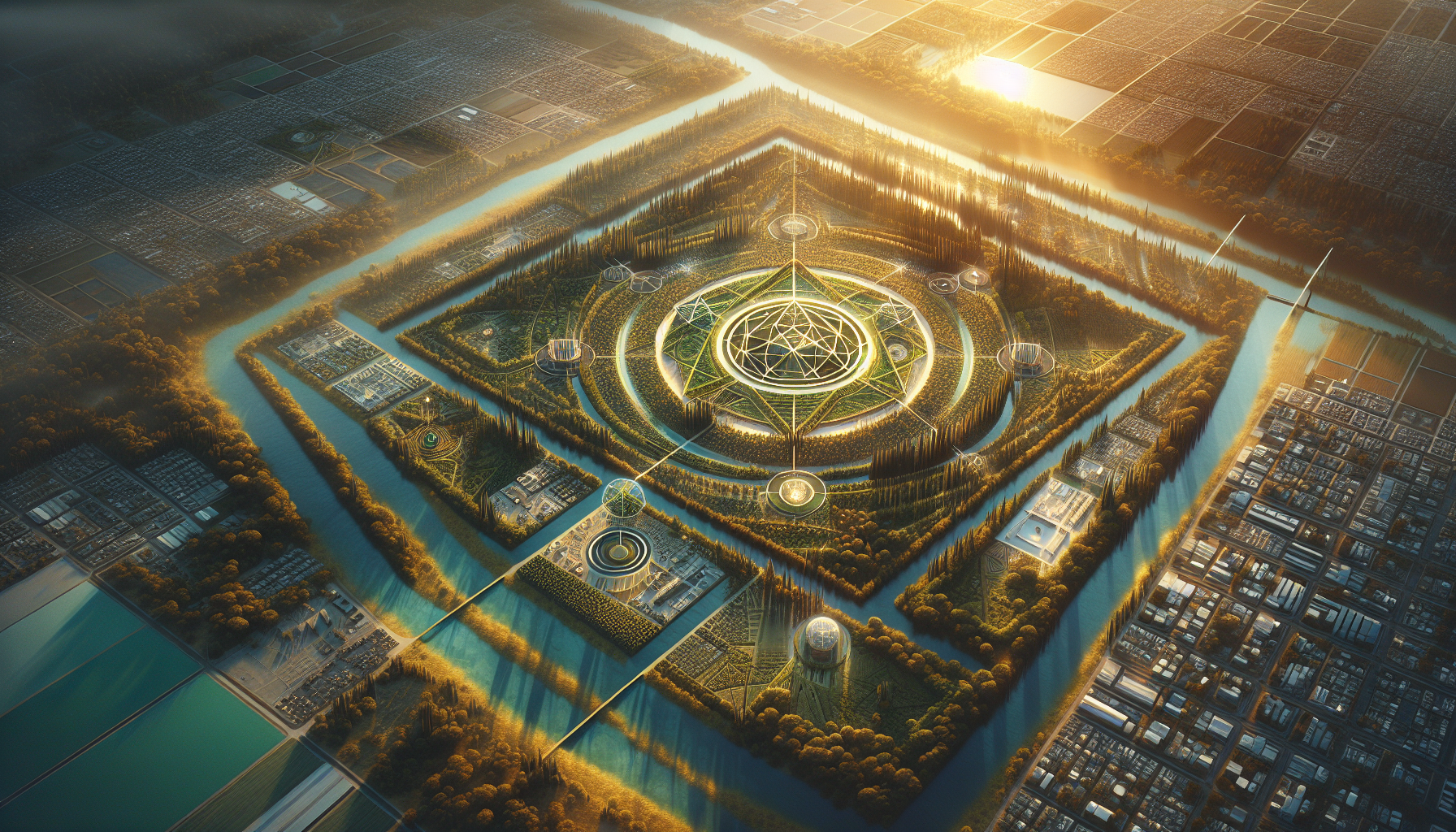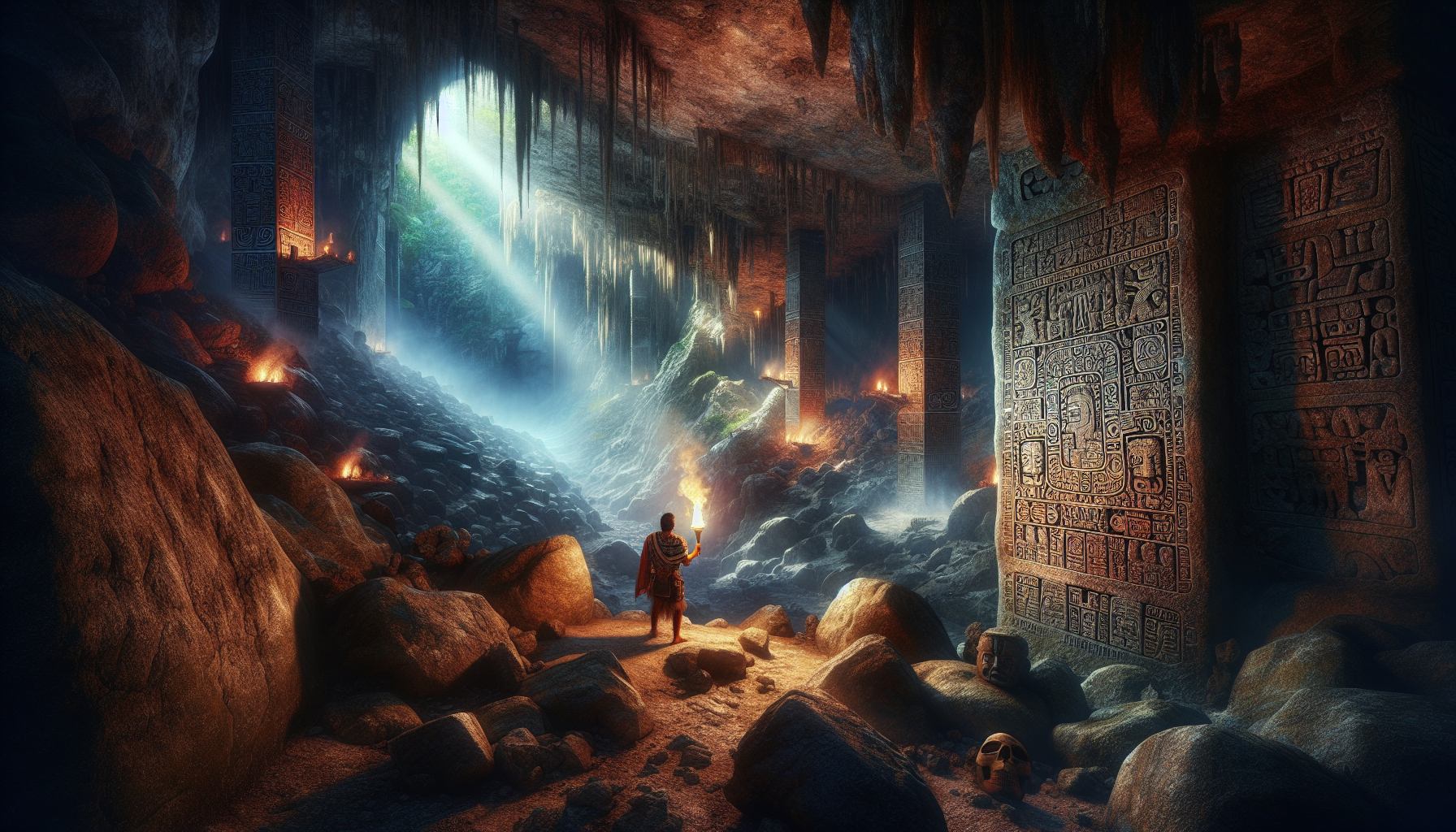In a world that’s increasingly urbanized and dominated by concrete jungles, the quest for harmony with nature has never been more pressing. As cities expand and rural areas undergo rapid transformation, the need to integrate sustainable development with age-old wisdom becomes a paramount concern. This is where the intriguing realm of sacred geometry enters the conversation—a fascinating field that holds the potential to bridge the gap between modern land development and ancient principles of harmony and balance.
Sacred geometry, often seen as the blueprint of the universe, represents the hidden patterns that govern the structure of everything around us. From the intricate spirals of a nautilus shell to the majestic symmetry of a sunflower, these geometric principles are not just confined to the natural world. They have been revered and utilized by various cultures for millennia, influencing everything from architectural wonders to spiritual practices. But what if we could harness these timeless patterns to inform contemporary land division, creating spaces that resonate with both environmental integrity and human well-being? 🌍
This article embarks on an exploratory journey to uncover the secrets of sacred geometry and its potential application in land division. We’ll delve into the rich historical tapestry of sacred geometry, tracing its roots from the ancient Egyptians and Greeks to its presence in the art and architecture of the Renaissance. By understanding these historical applications, we can begin to appreciate the profound impact that geometric principles can have on creating spaces that promote balance and harmony.
Our exploration will also address the practical aspects of integrating sacred geometry into modern land development. We’ll examine real-world examples where these principles have been successfully applied, resulting in environments that not only meet functional needs but also enhance the aesthetic and spiritual experience of their inhabitants. From urban planning to landscape design, sacred geometry offers a compelling framework for creating spaces that are not only sustainable but also soulful.
As we navigate through this intricate topic, we’ll also confront the challenges and misconceptions surrounding the use of sacred geometry in development. Is it feasible to incorporate such ancient wisdom into the fast-paced demands of modern construction? Can these principles truly contribute to more sustainable and harmonious communities, or are they merely esoteric ideals? By the end of this comprehensive exploration, you will be equipped with a deeper understanding of how sacred geometry can serve as a guiding light in the quest for balanced development. Join us as we unlock the secrets of sacred geometry and discover how these ancient patterns can lead us to a more harmonious future. 🌟
Understanding Sacred Geometry
Sacred geometry is a term used to describe the geometric laws and patterns that are foundational to the universe’s structure. These patterns can be seen in natural formations, the cosmos, and within architectural structures across the globe. The belief is that understanding and utilizing these patterns can lead to more harmonious and balanced creations. The principles of sacred geometry are often traced back to ancient civilizations, where they were considered crucial for the design of everything from buildings to art. The intricate designs often carry spiritual significance, representing the interconnectedness of all things.
At its core, sacred geometry emphasizes symmetry and proportion, echoing the harmony found in nature. This approach is not just about aesthetics but involves a deeper understanding of how each shape and pattern can impact the energy and balance of a space. The Golden Ratio, the Flower of Life, and the Fibonacci sequence are just a few examples of these fundamental patterns that have influenced architecture, art, and spirituality throughout history. By incorporating these principles into modern design, we can create spaces that are not only beautiful but also energetically aligned with nature.
One of the most compelling aspects of sacred geometry is its universal application. Whether it’s the spiral of a seashell, the hexagonal patterns of a honeycomb, or the branching patterns of trees, these geometric principles are evident in both natural and man-made environments. This universality suggests a hidden order and harmony within the universe, which can be tapped into through intentional design. Embracing these ancient principles in contemporary development can lead to spaces that are not only aesthetically pleasing but also resonate with the natural world’s intrinsic order.
The Role of Sacred Geometry in Land Division
Land division, when approached through the lens of sacred geometry, involves more than just dividing plots of land for construction. It considers the energy flow, natural formations, and existing ecosystems to ensure that development is in harmony with its surroundings. This approach can help prevent the disruption of local wildlife, preserve natural resources, and create spaces that are both sustainable and aesthetically pleasing. By aligning land division with sacred geometric principles, developers can create communities that enhance the well-being of their inhabitants and the environment.
The challenge lies in integrating these principles into modern urban planning and development. Traditional approaches often prioritize economic gain over environmental and spiritual considerations, leading to developments that can be unsustainable and disruptive. However, by re-evaluating these priorities and incorporating sacred geometry into the planning process, developers can create spaces that promote balance and harmony. This approach requires a deep understanding of the land, including its history, existing ecosystems, and the needs of the community.
To illustrate the impact of sacred geometry on land division, consider the following table, which compares traditional land division methods with those guided by sacred geometric principles. By examining the differences, we can better understand the potential benefits of this ancient approach.
| Aspect | Traditional Land Division | Sacred Geometry-Based Land Division |
|---|---|---|
| Focus | Maximizing usable space | Harmonizing with natural patterns |
| Environmental Impact | Often disregarded | Integrated into the design |
| Aesthetic Appeal | Functional | Balanced and beautiful |
Check out this YouTube video on Sacred Geometry in Urban Planning by Geo Harmony.
Applications in Architecture and Design
The influence of sacred geometry extends beyond land division to architecture and design. Many famous structures, such as the Parthenon in Greece and the Great Pyramid of Giza, are believed to have been built using these principles. The inclusion of geometric patterns in these structures is not merely decorative but serves to create spaces that resonate with the natural world. This resonance is said to enhance the energy of the space, promoting peace, creativity, and well-being for its inhabitants.
Modern architects and designers are increasingly looking to these ancient principles to inspire their work. By understanding the symbolic meanings and energy dynamics of different geometric shapes, they can create designs that not only meet functional needs but also elevate the human experience. This approach requires a shift in perspective, viewing design as a holistic practice that considers the interconnectedness of form, function, and energy.
One of the challenges of applying sacred geometry in modern design is balancing the aesthetic and functional needs with the spiritual and energetic considerations. Designers must be adept at translating these principles into practical applications, often requiring innovative solutions. The result can be spaces that are not only sustainable and efficient but also deeply harmonious and inspiring. Here are some practical applications of sacred geometry in design:
- Incorporating the Golden Ratio into building layouts and facades to enhance visual harmony.
- Using mandala-like patterns in floor designs to promote balance and tranquility.
- Aligning structures with cardinal points to optimize energy flow.
Each of these applications serves to create environments that not only function effectively but also foster a deeper connection with the natural world and its inherent beauty.

Conclusion
Unlocking the secrets of sacred geometry and its application to land division is a journey through time and space, bridging the wisdom of ancient civilizations with modern development practices. As we’ve explored in this article, sacred geometry is not merely an abstract concept but a tangible framework that has guided human construction and planning for centuries. It is rooted in the recognition that the universe, at its core, operates according to precise mathematical principles, and by aligning with these principles, we can create spaces that resonate with harmony and balance.
Throughout our exploration, we delved into the foundational elements of sacred geometry, understanding its significance in various cultures. From the Pythagorean solids to the intricate patterns found in nature, sacred geometry serves as a testament to the inherent order of the universe. Ancient societies, such as the Egyptians and the Greeks, harnessed this knowledge in their architectural endeavors, creating structures that continue to inspire awe today. These principles are not just relics of the past but are increasingly relevant as we seek sustainable and harmonious development solutions in our rapidly urbanizing world.
A key aspect of our discussion centered on how sacred geometry can inform land division and urban planning. By integrating these principles, developers and architects can create environments that are not only aesthetically pleasing but also functional and in harmony with natural laws. This approach can lead to enhanced community well-being, fostering spaces that promote social interaction, mental health, and a deep connection with nature.
Moreover, the environmental benefits of employing sacred geometry in land division are substantial. As we strive for sustainable development, aligning our urban landscapes with natural patterns can reduce ecological footprints and promote biodiversity. The fractal patterns found in sacred geometry, for instance, mirror those in ecosystems, offering a blueprint for creating urban areas that support rather than disrupt natural processes.
It’s essential to acknowledge that while the integration of sacred geometry in modern land division is promising, it requires a multidisciplinary approach. Collaboration between architects, urban planners, ecologists, and local communities is crucial to ensure that developments are not only innovative but also culturally and environmentally sensitive. This holistic approach can lead to spaces that honor both human creativity and the natural world, fostering environments where people and nature coexist in harmony.
As we conclude our exploration, the importance of embracing sacred geometry in development practices becomes evident. It offers a path towards creating spaces that nurture the human spirit while respecting the planet’s ecological balance. By drawing on ancient wisdom, we can address contemporary challenges with a renewed perspective, paving the way for a future where development is synonymous with sustainability and harmony.
We invite you, our readers, to reflect on the insights shared in this article and consider how you might incorporate the principles of sacred geometry into your own environments. Whether you’re an architect, urban planner, or simply someone passionate about creating harmonious spaces, there’s an opportunity to apply these timeless principles in innovative ways. 🌿
Your thoughts and experiences are invaluable, and we encourage you to share them in the comments section. By engaging in this dialogue, we can collectively advance our understanding and application of sacred geometry, inspiring change in our communities and beyond. Additionally, feel free to share this article with others who might be interested in exploring these ideas further.
Together, let’s unlock the potential of sacred geometry to transform our world, one space at a time. 🌟
Toni Santos is a visual storyteller and symbolic naturalist whose creations explore the hidden ecologies and forgotten bonds between humans and nature, as whispered through ancient lore. Through an intuitive and myth-sensitive lens, Toni reveals the sacred choreography between flora, fauna, and human spirit — a world where trees once spoke, rivers remembered, and every herb carried a secret name.
His journey is rooted in the esoteric — in the rituals of forest-dwellers, the botanical codes of shamans, and the unspoken pacts that shaped how ancient peoples lived in deep, reciprocal harmony with the natural world. From sacred groves to serpent-guarded springs, each of Toni’s works reflects a symbolic relationship long obscured by modern forgetfulness.
With a background in visual design and ancestral aesthetics, Toni merges storytelling with sacred ecology. His pieces don’t simply illustrate — they channel. Drawing from myth, mysticism, and lost herbal traditions, he crafts visuals that resonate with the old wisdom: that nature is not background, but kin.
As the creative spirit behind Vizovex, Toni shares collections, visual studies, and articles that illuminate the occulted connections between human life and the wild world. His work calls on us to remember — not just with the mind, but with the senses and the soul — the profound dialogues our ancestors once had with earth, plant, and animal.
His work is a tribute to:
The mythic language of trees, stones, and roots
Forgotten pacts between healers and the wilderness
The sacred knowledge carried in nature’s unseen patterns
Whether you’re a seeker of ancient plant-lore, a mystic attuned to seasonal cycles, or simply someone who hears the forest speak, Toni welcomes you to wander a space where symbolism, nature, and spirit entwine — one myth, one leaf, one vision at a time.





